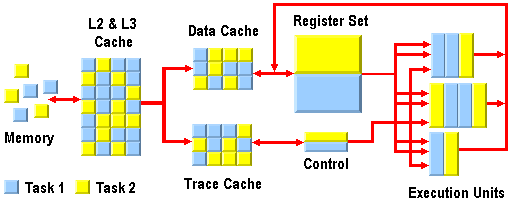Virtually all contemporary operating systems divide their work load up into processes and threads that can be independently scheduled and dispatched to run on a processor. The same division of work load can be found in many high-performance applications such as database engines, scientific computation programs, engineering-workstation tools, and multi-media programs. To gain access to increased processing power, most contemporary operating systems and applications are also designed to execute in dual- or multi-processor environments, where – through the use of symmetric multiprocessing (SMP) – processes and threads can be dispatched to run on a pool of processors.
Hyper-Threading technology leverages this support for process- and thread-level parallelism by implementing two logical processors on a single chip. This configuration allows a thread to be executed on each logical processor. Instructions from both threads are simultaneously dispatched for execution by the processor core. The processor core executes these two threads concurrently, using out-of-order instruction scheduling to keep as many of its execution units as possible busy during each clock cycle.

Architecturally, a processor with Hyper-Threading technology is viewed as consisting of two logical processors, each of which has its own IA-32 architectural state. After power up and initialisation, each logical processor can be individually halted, interrupted, or directed to execute a specified thread, independently from the other logical processor on the chip. The logical processors share the execution resources of the processor core, which include the execution engine, the caches, the system bus interface, and the firmware.
Legacy software will run correctly on a HT-enabled processor, and the code modifications to get the optimum benefit from the technology are relatively simple. Intel estimates that a performance gain of up to 30% is possible, when executing multi-threaded operating system and application code. Moreover, in multi-processor environments the increase in computing power will generally scale linearly as the number of physical processors in a system is increased.
- Pentium Architecture
- Pentium Pro
- Pentium MMX Technology
- Pentium II
- Pentium SEC
- Pentium “Deschutes
- Pentium Xeon
- Pentium III
- Pentium Tualatin
- Pentium 4
- Pentium Northwood
- Hyper-Threading Technology
- Pentium Prescott
- Pentium Processor Numbers
- Multi-Core Processors
- Pentium Smithfield
- Pentium D
- Pentium Roadmap